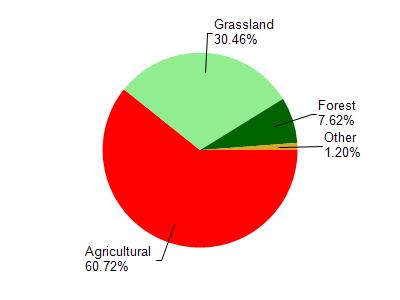Lafayette
No
No
Yes
Fish and Aquatic Life
Overview
Originating near the village of Wiota, this small stream flows southerly into the Pecatonica River. Little is known about this stream. The Surface Waters of Lafayette County (1967) reports that “if it were not for its scouring floods during periods of heavy runoff it might qualify as a marginal trout stream.” The report goes on to say that “the steep banks and lack of general watershed cover in conjunction with the steep nature of the surrounding landscape do not favor a permanent fishery.” Fago (1976) reports finding low numbers of tolerant warm water forage species.
Date 2002
Author Aquatic Biologist
Historical Description
Feather Branch is a rather insignificant spring-fed stream which flows southerly irito the West Branch of the Pecatonica River. Presently, it is managed for forage fishes. If it were not for its scouring floods during periods of heavy run off it might qualify as a marginal trout stream. Also, its steep, straight banks and lack of general watershed cover in conjunction with the steep nature of the surrounding landscape do not favor a permanent fishery.Most of the stream bottom consists of silt in the lower section and gravel in the upper sections. Game assets are limited due to lack of ground cover and wetlands throughout the watershed. It is accessible from several town road right-of-ways.
Feather Branch, T1N, R4E, Sections 1-5, Surface acres- = 1.7, Miles = 3.8, Gradient = 37.3 feet per mile; Total alkalinity = 324 mg/l, Volume of flow = 1.6 cfs.
From: Piening, Ronald; Poff, Ronald; Threinen, C.W., 1967. Lake and Stream Classification Project. Surface Water Resources of Lafayette County, Wisconsin Department of Natural Resources, Madison, WI.
Date 1967
Author Aquatic Biologist
Impaired Waters
Feather Branch (917400) was assessed during the 2016 listing cycle; total phosphorus sample data exceed 2016 WisCALM listing criteria for the Fish and Aquatic Life use and biological impairment was observed (i.e. at least one macroinvertebrate or fish Index of Biotic Integrity (IBI) scored in the poor condition category).
Date 2015
Author Aaron Larson
Condition
Wisconsin has over 84,000 miles of streams, 15,000 lakes and milllions of acres of wetlands. Assessing the condition of this vast amount of water is challenging. The state's water monitoring program uses a media-based, cross-program approach to analyze water condition. An updated monitoring strategy (2015-2020) is now available. Compliance with Clean Water Act fishable, swimmable standards are located in the Executive Summary of Water Condition in 2018. See also the 'monitoring and projects' tab.
Reports
Management Goals
Wisconsin's Water Quality Standards provide qualitative and quantitative goals for waters that are protective of Fishable, Swimmable conditions [Learn more]. Waters that do not meet water quality standards are considered impaired and restoration actions are planned and carried out until the water is once again fishable and swimmable
Management goals can include creation or implementation of a Total Maximum Daily Load analysis, a Nine Key Element Plan, or other restoration work, education and outreach and more. If specific recommendations exist for this water, they will be displayed below online.
Monitoring
Monitoring the condition of a river, stream, or lake includes gathering physical, chemical, biological, and habitat data. Comprehensive studies often gather all these parameters in great detail, while lighter assessment events will involve sampling physical, chemical and biological data such as macroinvertebrates. Aquatic macroinvertebrates and fish communities integrate watershed or catchment condition, providing great insight into overall ecosystem health. Chemical and habitat parameters tell researchers more about human induced problems including contaminated runoff, point source dischargers, or habitat issues that foster or limit the potential of aquatic communities to thrive in a given area. Wisconsin's Water Monitoring Strategy was recenty updated.
Grants and Management Projects
| Project Name (Click for Details) | Year Started |
|---|
|
|
Monitoring Projects
| WBIC | Official Waterbody Name | Station ID | Station Name | Earliest Fieldwork Date | Latest Fieldwork Date | View Station | View Data |
|---|
| 917400 | Feather Br | 333052 | Feather Branch at Tn Rd Bl Wiota Dry | 4/24/1975 | 5/3/1977 | Map | Data |
| 917400 | Feather Br | 10031547 | Feather Branch at W. Church Road | 10/14/2010 | 1/1/2015 | Map | Data |
| 917400 | Feather Br | 10058678 | Feather Branch Spring | | | Map | Data |
| 917400 | Feather Br | 10014322 | Feather BranchatSouth Road | | | Map | Data |
|

Watershed Characteristics
Feather Br is located in the Lower Pecatonica River watershed which is 134.23 mi². Land use in the watershed is primarily agricultural (60.60%), grassland (30.40%) and a mix of forest (7.60%) and other uses (1.20%). This watershed has 333.90 stream miles, 40.87 lake acres and 274.90 wetland acres.
Nonpoint Source Characteristics
This watershed is ranked Not Ranked for runoff impacts on streams, Not Ranked for runoff impacts on lakes and High for runoff impacts on groundwater and therefore has an overall rank of High. This value can be used in ranking the watershed or individual waterbodies for grant funding under state and county programs.However, all waters are affected by diffuse pollutant sources regardless of initial water quality. Applications for specific runoff projects under state or county grant programs may be pursued. For more information, go to surface water program grants.